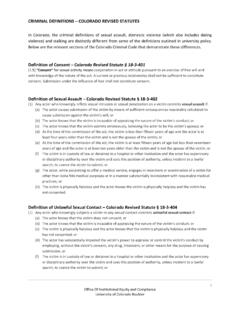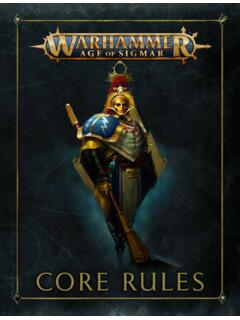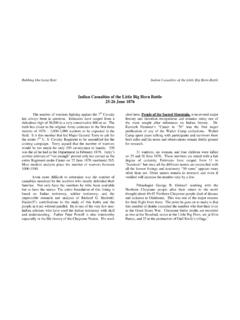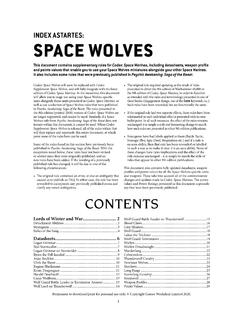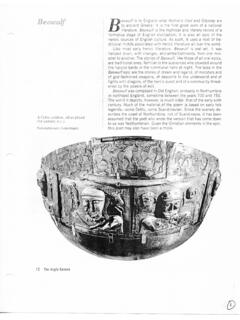Transcription of Samurai Life in Medieval Japan - Home | University of ...
1 Imaging Japanese History Program for Teaching East Asia, University of Colorado Page 1 Handout M2 (Print Version)Page 1 of 8 Samurai Life in Medieval Japan The Heian period (794-1185) was followed by 700 years of warrior governments the Kamakura, Muromachi, and Tokugawa. The civil government at the imperial court continued, but the real rulers of the country were the military daimy class. You will be using art as a primary source to learn about Samurai and daimy life in Medieval Japan (1185-1603). Kamakura Period (1185-1333) The Kamakura period was the beginning of warrior class rule. The imperial court still handled civil affairs, but with the defeat of the Taira family, the Minamoto under Yoritomo established its capital in the small eastern city of Kamakura. Yoritomo received the title shogun or barbarian-quelling generalissimo.
2 Different clans competed with one another as in the H gen Disturbance of 1156 and the Heiji Disturbance of 1159. During the Genpei Civil War of 1180-1185, Yoritomo fought against and defeated the Taira, beginning the Kamakura Period. Yoritomo chose officials called shugo (military governors) in each province to be responsible for military control of the provinces, to supervise the land, and to collect taxes. Obligation and dependency between shogun and military governors became the basis for the governing system until the end of the nineteenth century. As the shugo gained power and no longer acted only on behalf of the shogun, they evolved into the daimy of the late fifteenth century. It also should be clarified that only about 10 percent of the population were of this warrior culture. Most Japanese at the time were farmers. The Heiji Monogatari Emaki is a hand scroll showing the armor and battle strategies of the early Medieval period.
3 The conflict at the Sanj Palace was between Fujiwara Nobuyori and Minamoto Yoshitomo. As you look at the scroll, notice what people are wearing, the different roles of Samurai and foot soldiers, and the different weapons. What can you learn about what is involved in this disturbance? What can you learn about the Samurai and the early Medieval period from viewing this scroll? What information is helpful in developing an accurate view of Samurai ? What preparations would be necessary to fight these kinds of battles? (Think about the organization of people, equipment, and weapons; the use of bows, arrows, and horses; use of protective armor for some but not all; and the different ways of fighting.) The Battles of Ichinotani and Yashima screens were painted in the seventeenth century but highlight the bravery, loyalty, and strategy of the Genpei War battles at Ichinotani and Yashima.
4 Notice the use of horse and bow. What information here informs your understanding of what a Samurai does? Imaging Japanese History Program for Teaching East Asia, University of Colorado Page 2 Handout M2 (Print Version) Page 2 of 8 Daily Life: War and Play In this early Medieval period, wealth and leadership shifted away from the emperor and nobility to the warrior government. In order to govern, the shugo had to blend military and civilian arts. They may have conquered brutally, but shugo could not administer without the prestige of culture. A common saying was, the warrior needs to master the bow and the horse as well as the brush and the word. Shugo had to write correspondence and documents to deal with legal matters and to govern.
5 Leisure time was influenced by the arts and Zen Buddhism. Shugo wrote poetry, practiced calligraphy, studied Buddhist sutras. Some painted while others appreciated art. Buddhist monks, especially the Zen Buddhists, became their teachers and cultural guides. The monks role as advisors and friends became important to the warrior elite and influenced the cultural traditions and activities of later daimy . Military Skills and Preparation Early Medieval warriors depended on the bow and the horse. Mounted archery, called yabusame, was a skill Samurai practiced to stay battle-ready. Yabusame also taught the Samurai focus and discipline. The bows were large; the more men it took to string the bow, the stronger the Samurai . Tales speak of heroic men who used bows that took seven men to string! Worrisome Political Realities In the beginning, warrior society was founded on family ties.
6 Samurai or vassals would serve a shugo in return for land or reward. This idealized relationship meant a vassal would be loyal for a lifetime and even be prepared to die for his lord. This ideal could not really exist because a warrior had to earn a living, and allegiance to a losing lord meant losing your means of making a living. Choosing the right alliances and being on the winning side meant more reward and fame. Alliances sometimes changed in battles. Brothers were known to kill brothers and sons their fathers if it furthered their power. The shugo, and later the daimy , changed their loyalties based on favorable outcomes. Along the road Smoke from Mt Fuji Could not be distinguished In a sky Of unbroken cloud. A waka (Japanese poem) by Shogun Yoritomo, quoted in Japan : The Shaping of Daimy Culture Study the pictures of current bows made to copy those of the past.
7 Imaging Japanese History Program for Teaching East Asia, University of Colorado Page 3 Handout M2 (Print Version) Page 3 of 8 Heroic Values We learn about this early Medieval time period from a genre of literature called the war tales. These stories are a mixture of fact and fiction. They were originally sung by balladeers. The H gen Monogatari, Heiji Monogatari, and The Tale of the Heike are among the stories of the battles during the Kamakura. Although they were written 200 years later, they tell heroic stories that reflect the values and ideals of the twelfth-century Samurai . End of the Kamakura Period In 1274, the Kamakura shogunate faced two Mongol invasions.
8 Luckily, both were unsuccessful due to typhoons that forced the Mongols to retreat. Some believed that the Shinto gods had sent these kamikaze (or divine winds). The shogunate was strained by preparing to fend off the Mongols. Many warriors were called in to help. When the second invasion in 1281 was thwarted, however, there was no way to reward the warriors . Financial problems weakened the Kamakura government, and it ended when the H j regents could not put down an uprising led by the emperor. The breakdown of imperial authority continued, even though the emperor still had legitimacy. A power struggle erupted between the Northern Court, as represented by the rival Samurai family, the Ashikaga, and the Southern Court, who followed the emperor. Two imperial courts existed during 40 years of warfare between these two factions. It ended with the Ashikaga Yoshimitsu unifying the two courts.
9 Find the view of a warrior fighting the Mongols. Takezaki Suenaga had handscrolls painted to glorify his bravery and to identify his contribution to the defense of his country. He hoped he would be richly awarded for his efforts. Notice his armor, weapons, and horse. The exploding item is an invention of the Mongols. Friends and foes alike wet their sleeves with tears and said What a pity! Tadanori was a great general, Pre-eminent in the arts of both sword and poetry. Yorimasa summoned Watanabe Chujitsu Tonau and ordered: Strike off my head. Tonau could not bring himself to do this while his master was still alive. He wept bitterly. How can I do that, my lord? he replied. I can do so only after you have committed suicide. I understand, said Yorimasa. He turned to the west, joined his palms, and chanted Hail Amidha Buddha ten times in a loud voice.
10 Then he composed this poem: Like a fossil tree Which has borne not one blossom Sad has been my life Sadder still to end my days Leaving no fruit behind me. Having spoken these lines, he thrust the point of his sword into his belly, bowed his face to the ground as the blade pierced him through, and died. Tonau took up his master s head and, weeping, fastened it to a stone. Then, evading the enemy, he made his way to the river and sank it in a deep place. Excerpted from The Tale of the Heike Imaging Japanese History Program for Teaching East Asia, University of Colorado Page 4 Handout M2 (Print Version) Page 4 of 8 Muromachi Period (1336-1573) The Muromachi district of Kyoto became the capital for the second period in Medieval Japanese history.








